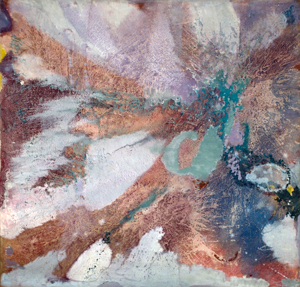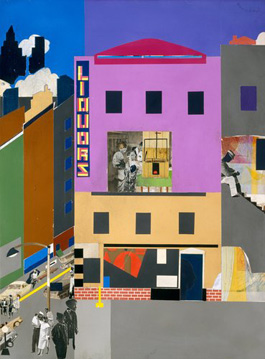Twice Around the Block
John Haberin New York City
Romare Bearden: abstract art and The Block
When Romare Bearden looked at African Americans, he saw his roots in the jazz era and in Harlem. He looked at abstract art the same way. Together with The Block, his abstractions help sort out his sense of community and his Modernism.
Bearden always looked to the community and to Modernism. He took Cubism's crisp edges and sudden leaps of the imagination, and he gave them jazz rhythms. He rooted art and jazz in a place and time, but a shifting place in time, from North Carolina to Harlem streets. And he saw them not solely as an odyssey, but as a different kind of journey altogether—into the space of memory. As much as anyone, he could present the lives he lived and the lives he knew as an African American culture. 
Canvas and the cave
Romare Bearden encompassed or inspired a century of African American Modernism and then some, so why not also abstraction? And he did paint abstractly, if only briefly starting in 1957. The consummate artist of the jazz age had taken time off for military service and then songwriting, and how better to resume his engagement with art? He could remind himself what made him an artist in the first place and discover oil on canvas as if inventing them from scratch. He could ask himself what made others around him artists as well, at a time of color-field painting and poured paint. He could refuse to be pigeonholed as a Pop artist, for all his years of cut and paste.
You could easily forget that the work existed, assuming that you have ever encountered it. Like me, you might have lingered over a Bearden retrospective in 2005, a Bearden centennial in 2011, and the Harlem Renaissance at the Met in 2024 without taking note of it for so much as a moment. You could have made it through museum surveys of black abstraction and Black Power, with an entire floor for abstraction, without a trace of him. It might seem incomprehensible that he would turn away from the news just as the civil-rights movement was demanding attention as never before. Whatever happened to culture, collage, and community? But he did, and it enabled some of his largest and most richly layered work.
He may have wanted to work against the grain, knowing his own weakness for nostalgia and quick results. Collage could come fast and furious, but now he could slow down. He might have found it an obligation at that, from an artist always of his time. His gallery back then, I learned, represented Robert Motherwell, Adolph Gottlieb, and William Baziotes and exhibited Arshile Gorky and Hans Hofmann. Like Jackson Pollock, he began an abstract painting with canvas on the floor, approaching it from four sides. At the same time, he refused the automatic gestures of his contemporaries, as if teaching them a lesson.
Not that Bearden had given up entirely on collage. After staining and splattering the canvas, he cut it in pieces and reassembled them. Their outlines become the composition, and they often resemble the human silhouettes in his more familiar work on paper, only stranger. Their well-worked surface has the texture of human skin. Nor had he given up on myth. He set aside such themes as the fall from Paradise and the Odyssey, but the results look like nothing so much as cave painting under torch light.
They invite one up close, into the cave, to study the working. Cut canvas also has a parallel in Lucio Fontana and Arte Povera in Italy, and the identification of painting with calligraphy reflects a growing interest in Chinese art. As a title puts it, he sought Old and New. If he could not accept chance, he could at least maintain his ties to jazz improvisation, now filtered through Zen. Still, the subdued colors appear as through a mist or a sheet of ice. Other titles speak of a strange land, of autumn, and of ghosts.
Before long he had to emerge from the cave and into the light. Primitivism was just not for Bearden, however sophisticated. Politics alone was calling him to bear witness, and he founded Spiral in 1963 with other African American artists in New York, including Hale Woodruff, Emma Amos, Charles Alston, and Norman Lewis. He reserved his greatest tribute to Harlem for 1978, with the eighteen-foot length of The Block, and he lived to 1988. In the end, neighborhood institutions meant more to him than anything but art. Activism and myth alike called for no less.
Blockbuster
After the tributes in "The Bearden Project," how about the real thing? And the Met had an entire block in 2011, as its part in the Bearden centennial. Make that The Block, in all its six panels and eighteen feet.  One expects to go back in time or into myth. One expects to see people together, because Bearden saw entire lives as a thousand rituals—and one finds them, too, but one may not expect the rough edges or the darkness, from an artist who associated cutting things up with putting them back together and with warmth. One can have no doubt why Kira Lynn Harris selected it for her own riff on the Bearden centennial and the community (and I have more on her riff with my survey of his influence).
One expects to go back in time or into myth. One expects to see people together, because Bearden saw entire lives as a thousand rituals—and one finds them, too, but one may not expect the rough edges or the darkness, from an artist who associated cutting things up with putting them back together and with warmth. One can have no doubt why Kira Lynn Harris selected it for her own riff on the Bearden centennial and the community (and I have more on her riff with my survey of his influence).
As eighteen-foot murals go, this one looks quite small. Maybe it has to, with Lennox Avenue (now Malcolm X Boulevard), seven blocks north of the Studio Museum today, transported to Museum Mile on the the stately Upper East Side. Maybe it has to, too, in a corridor outside the twentieth-century wing, like the one that a floor above serves as a gift shop. Surely it has to after Harris, on four surrounding walls. Still, Bearden must have meant the intimacy, in breaking things down into separate works on paper. He had learned early on from the Mexican muralists, like Diego Rivera, but he will not elevate day-to-day suffering by identifying the work with the wall.
Of course one expects the color, for this is Bearden and collage. One may not expect how often he muted it, much as in his abstraction—whether in black-and-white clippings or, especially in the second and third panel, scraping things down. Not just at a funeral, but also in their moments of leisure, men and cars are in black. From the silhouette of buildings beyond the rooftops or the people in bed, it could be night. From the color, the activity, the boy and girl playing tag, or a mother and child on the street, it could be day. From the figure sleeping out on the sidewalk or the yellow circle of sun or full moon, it could well be either one.
It is by no means a simple journey into and out of night, like another version of his Odyssey. One does not expect Harris's dreaminess and inner lives, for Bearden was an extrovert in his art, but this time he omits the jazz musicians and jazz rhythms. Crowds never quite come together, and the funeral mass sways as in a slow dance. One does not expect the contemporary community in the cutout block in "The Bearden Project," by Hank Willis Thomas, for this is Harlem forty years ago, but here Bearden leaves out his prophets and conjure women in favor of a liquor store and a barber shop without a quartet. Each scene could be a collection of case studies, and at age sixty the artist was only recently still a welfare case worker. He must have paid attention.
Harris turns out to pick up pretty much all her motifs after all—the diagonal traffic, the couple making love, the figure leaning out, the shades pulled down, and even the descending angel. In fact Bearden throws in a good seven angels, in one surrounded by four more like a Baroque Madonna, another above seated on the roof, and yet another invading someone's room. Still, the first seems more comedy than salvation and is all but rubbed out, the last is reduced to argument, and the one above is just taking a rest. The faces in the windows are half barred by the shades, desperate, or impassive, and a head like an Easter Island totem bars a door. The lovemaking comes close to violence, and others in bed are not getting much sleep. The only kids with time to relax are watching TV.
One can see Harris and Bearden as both representing silence, but for one the silence of reflection and the other of muteness. Even Bearden's Baptist Church looks silenced. Collage or abrasion makes pretty much everything else, too, look peeling or boarded up. The flea-bag above the liquor store has a giant mousetrap and a man in boxing gloves. One knows all the elements, the colors, and the rituals, but the glibness of just another Bearden pretty much vanishes up close. For all that, nothing boils over into conflict, and a full block has all the components of sustained life.

Romare Bearden in abstraction ran at D. C. Moore through March 28, 2020, "The Block" at The Metropolitan Museum of Art through January 8, 2012. Related reviews looks at Romare Bearden in retrospective and "The Bearden Project."




